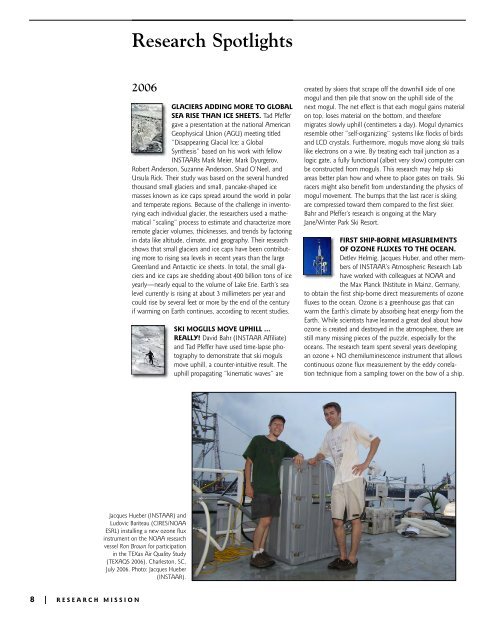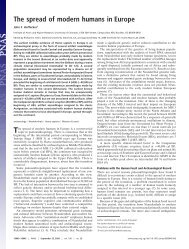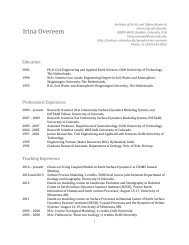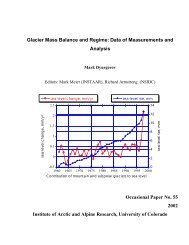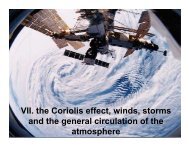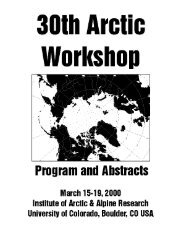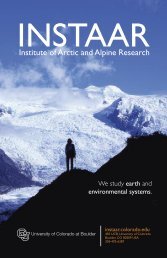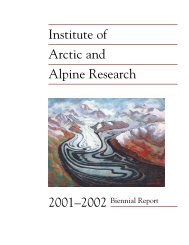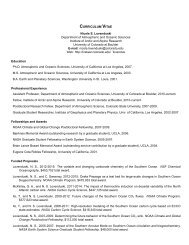00_cover_Biennial Report 05-06.qxd - INSTAAR - University of ...
00_cover_Biennial Report 05-06.qxd - INSTAAR - University of ...
00_cover_Biennial Report 05-06.qxd - INSTAAR - University of ...
- No tags were found...
Create successful ePaper yourself
Turn your PDF publications into a flip-book with our unique Google optimized e-Paper software.
Research Spotlights2<strong>00</strong>6GLACIERS ADDING MORE TO GLOBALSEA RISE THAN ICE SHEETS. Tad Pfeffergave a presentation at the national AmericanGeophysical Union (AGU) meeting titled“Disappearing Glacial Ice: a GlobalSynthesis” based on his work with fellow<strong>INSTAAR</strong>s Mark Meier, Mark Dyurgerov,Robert Anderson, Suzanne Anderson, Shad O’Neel, andUrsula Rick. Their study was based on the several hundredthousand small glaciers and small, pancake-shaped icemasses known as ice caps spread around the world in polarand temperate regions. Because <strong>of</strong> the challenge in inventoryingeach individual glacier, the researchers used a mathematical“scaling” process to estimate and characterize moreremote glacier volumes, thicknesses, and trends by factoringin data like altitude, climate, and geography. Their researchshows that small glaciers and ice caps have been contributingmore to rising sea levels in recent years than the largeGreenland and Antarctic ice sheets. In total, the small glaciersand ice caps are shedding about 4<strong>00</strong> billion tons <strong>of</strong> iceyearly—nearly equal to the volume <strong>of</strong> Lake Erie. Earth’s sealevel currently is rising at about 3 millimeters per year andcould rise by several feet or more by the end <strong>of</strong> the centuryif warming on Earth continues, according to recent studies.SKI MOGULS MOVE UPHILL ...REALLY! David Bahr (<strong>INSTAAR</strong> Affiliate)and Tad Pfeffer have used time-lapse photographyto demonstrate that ski mogulsmove uphill, a counter-intuitive result. Theuphill propagating “kinematic waves” arecreated by skiers that scrape <strong>of</strong>f the downhill side <strong>of</strong> onemogul and then pile that snow on the uphill side <strong>of</strong> thenext mogul. The net effect is that each mogul gains materialon top, loses material on the bottom, and thereforemigrates slowly uphill (centimeters a day). Mogul dynamicsresemble other “self-organizing” systems like flocks <strong>of</strong> birdsand LCD crystals. Furthermore, moguls move along ski trailslike electrons on a wire. By treating each trail junction as alogic gate, a fully functional (albeit very slow) computer canbe constructed from moguls. This research may help skiareas better plan how and where to place gates on trails. Skiracers might also benefit from understanding the physics <strong>of</strong>mogul movement. The bumps that the last racer is skiingare compressed toward them compared to the first skier.Bahr and Pfeffer’s research is ongoing at the MaryJane/Winter Park Ski Resort.FIRST SHIP-BORNE MEASUREMENTSOF OZONE FLUXES TO THE OCEAN.Detlev Helmig, Jacques Huber, and other members<strong>of</strong> <strong>INSTAAR</strong>’s Atmospheric Research Labhave worked with colleagues at NOAA andthe Max Planck INstitute in Mainz, Germany,to obtain the first ship-borne direct measurements <strong>of</strong> ozonefluxes to the ocean. Ozone is a greenhouse gas that canwarm the Earth’s climate by absorbing heat energy from theEarth. While scientists have learned a great deal about howozone is created and destroyed in the atmosphere, there arestill many missing pieces <strong>of</strong> the puzzle, especially for theoceans. The research team spent several years developingan ozone + NO chemiluminescence instrument that allowscontinuous ozone flux measurement by the eddy correlationtechnique from a sampling tower on the bow <strong>of</strong> a ship.Jacques Hueber (<strong>INSTAAR</strong>) andLudovic Bariteau (CIRES/NOAAESRL) installing a new ozone fluxinstrument on the NOAA researchvessel Ron Brown for participationin the TEXas Air Quality Study(TEXAQS 2<strong>00</strong>6), Charleston, SC,July 2<strong>00</strong>6. Photo: Jacques Hueber(<strong>INSTAAR</strong>).8 | RESEARCH MISSION


